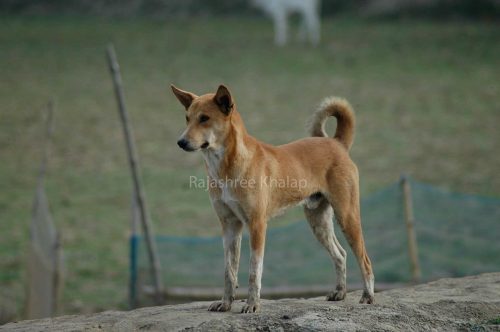By Aditya Panda

History & Description:
The Indian Native Dog, commonly referred to as the “pariah” dog, and erroneously referred to as “mongrel”, “mutt” or “stray”, in fact, represents one of the oldest breeds of domestic dog and belongs to the “primitive”/”aboriginal”/“Pariah” group of Canis familiaris. It is the naturally evolved and perfected prototype of the domestic dog. All modern breeds have been selectively bred out from this group of dogs by humans.
Since it is a naturally evolved breed, the standard isn’t rigid like those for breeds created by human selection. This standard deliberately remains flexible to make room for natural variations in size, colour, etc. observed among individuals, depending on various factors, mostly geographical.
Appearance:
It is a medium sized dog of square to slightly rectangular build and short coat. The dog has a double coat, a coarse upper coat and a soft undercoat. The most commonly observed colours are varying shades of solid fawn or pied (fawn/black and white). Solid blacks are rare. Spotted (Dalmatian like), brindle and white are considered faults. Spots are seen in the undercoat of pied dogs. White markings at the ends of limbs and tip of tail are common. Red/fawn dogs frequently have dark muzzles. The jaws have a clean, scissor bite.
The head is medium sized and wedge shaped. The muzzle is pointed and is of equal or slightly greater length than the head. The neck is noble and the forequarters are erect. Hind quarters are minimally angled. The trot is short. The eyes are almond shaped and dark brown in colour. The ears are held erect and are pointed at the tips, with a broad base, set low on the head and the tail is curled and held high, when excited.
Size:
Adult Dogs:
Height: 20 to 25 inches high at the withers
Weight: 20-30 kilogrammes
Adult Bitches:
Height: 18-23 inches at the withers
Weight: 15-25 kilogrammes
Temperament:
It is an extremely alert, very social dog. Its rural evolution, often close to forests where predators like tigers and leopards were common, has made it an extremely cautious breed and this caution is not to be mistaken for a lack of courage. They make excellent watch dogs and are very territorial and defensive of their pack/family. They need good socializing as pups and do well with families and children. However, they are not comfortable around strangers and can get defensive. They are highly intelligent and easily trainable, but can get bored equally easily and not want to play typical, repetitive dog games like ‘fetch’. Owners are frequently outsmarted by this expert of escape!
They are very modest eaters and will rarely overeat.
They are a very active breed and thrive with regular exercise and very long walks, several times a day.
They bark at the slightest doubt or provocation and can hence, be noisy.
Health Issues
Being a naturally evolved and perfected breed, they have very few health concerns and thrive with minimal ‘maintenance’, especially in tropical weather. They do not stand cold very well.
The skin needs very little grooming, and the dogs themselves are relatively clean. They almost have no body odour. Genetic health ailments like hip dysplasia, etc. are extremely rare since in a naturally evolved breed only the fittest breed and the flaws are bred out.
They are generally very healthy and average life expectancy is over 15 years under good care.
Breeding
Unlike other breeds, the pariah group of dogs, including the Indian Native Dog, breeds only once a year. The bitches come into season corresponding with the Indian South-West Monsoon, around July to October, and pups are whelped in winter, from October to December.
Faults:
Long coats, drooping ears, light eyes, white/spotted/brindle/liver coloured coat, oversized or undersized dogs, straight tails, overweight dogs, loose, drooping skin, short muzzle, overshot or undershot jaws, overly long loin and overly angled legs, cow hocks, bow legged-ness, heavily tucked ‘greyhound’ bodies.
